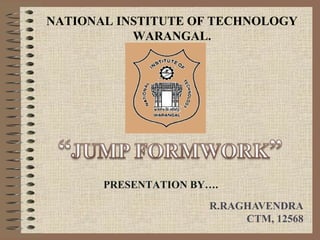
Jump Formwork
- 1. NATIONAL INSTITUTE OF TECHNOLOGY WARANGAL. PRESENTATION BY…. R.RAGHAVENDRA CTM, 12568
- 2. CONTENTS : 1. INTRODUCTION TO fORm wORk 2. DesIgN ReqUIRemeNTs 3. ClassIfICaTION CRITeRIa 4. JUmp fORm 5. TYpes Of JUmp fORm 6. pROCess effICIeNCY 7. safeTY & sUsTaINaBle feaTURes 8. CONsIDeRaTIONs 9. RefeReNCes
- 3. INTRODUCTION : For the different construction activities like Brick work above 5 ft Surface finishing works like plastering, painting, walling etc. Renovation, repair and alteration works. Roof and slab pouring Some temporary nature supports and structures are required like Formwork (Supporting Structure) Scaffoldings (arrangement for working plate forms) Shoring (supporting method for unsafe structure) Underpinning (Method of strengthening an existing structure’s footing)
- 4. WHAT IS FORMWORK: Formwork are temporary structures that are built to support parts or the whole of a permanent structure until it is self-supporting. Formwork means the surface, support and framing used to define the shape of concrete until it is self- supporting.
- 5. Design Requirements: • Strength • Speedy erection and dismantling • Tightness of joints • Rigidity • Reuse • Ease of handling
- 6. Classification Criteria for Formwork :- o Classification according to size o Classification according to the location of use o Classification according to materials of construction o Classification according to nature of operation o Classification according to brand name of the product
- 7. TYPES OF WALL FORMWORK (Based on nature of operation) JUMP FORM SLIP FORM TUNNEL FORM
- 8. JUMP FORM: Generally, jump form systems comprise the formwork and working platforms for cleaning/fixing of the formwork, steel fixing and concreting. Jump form, often described as climbing form. It is suitable for construction of multi-storey vertical concrete elements in high-rise structures, such as shear walls, core walls, lift shafts, stair shafts and bridge pylons. It is a highly productive system designed to increase speed and efficiency while minimizing labor and time.
- 10. TYPES OF JUMP FORMWORK Normal jump/climbing form Guided-climbing jump form Self-climbing jump form
- 11. WALL FORMING – JUMP FORM
- 12. SELF CLIMBING JUMP FORM
- 13. PROCESS EFFICIENCY : Fast construction can be achieved by careful planning of the construction process. Crane availability is critical for normal jump form. Self-climbing formwork cuts down the requirement for crane time considerably. By allowing the crane to be used for other construction work this may reduce the total number of cranes needed on site. The formwork is independently supported, so the shear walls and core walls can be completed ahead of the rest of the main building structure. This can help to provide stability to the main structure during its construction and can have the beneficial effect of taking the jump form core off the project critical path.
- 14. CONTINUED… High quality surface finishes are possible. Climbing forms can be designed to operate in high winds (when the use of a crane is less viable). This allows construction work to be carried out at reduced risk from adverse weather. The highly engineered nature of jump form systems allows quick and precise adjustment of the formwork in all planes. Some formwork systems can be used at an inclined angle, which is particularly useful on bridge pylons or where walls vary in thickness. A small but skilled workforce is required on site. It is easier to plan construction activities due to the repetitive nature of the work.
- 15. SAFETY : Working platforms, guard rails, and ladders are built into the completed units of market-leading formwork systems. Complete wind-shield protection on platform edges is also possible. Self-climbing formwork systems are provided with integral free- fall braking devices. The completed formwork assembly is robust and provides a stable working platform. The reduced use of scaffolding and temporary work platforms results in less congestion on site. The setting rate of concrete in those parts of the structure supporting the form is critical in determining the rate at which construction can safely proceed. The repetitive nature of the work means that site operatives can quickly become familiar with health and safety aspects of their job. Formwork suppliers provide materials and resources to help train the labour force.
- 16. SUSTAINABILITY FEATURES : The formwork system is easy to clean and reuse with little formwork waste generated compared to traditional formwork. Climbing formwork systems offer simplicity, safety and cost effectiveness for certain high-rise building structures. The repetitive nature of the work, combined with the engineered nature of the formwork, allows fine tuning of the construction operations, which in turn leads to minimal concrete wastage. Many repeated uses of formwork are possible before maintenance or replacement is needed, the number of uses depending on the quality of the surface finish of concrete specified.
- 17. CONSIDERATIONS : Jump form is typically used on buildings of 5 storey's or more; fully self-climbing systems are generally used on structures with more than 20 floor levels. Assembly and lifting operations for self-climbing formwork systems require personnel to be comprehensively trained to ensure competence. The raising operation must be carefully planned and coordinated, and access to the working area during lifting should be restricted to essential personnel.
- 18. REFERENCES : “FORMWORK FOR MODERN, EFFICIENT CONCRETE CONSTRUCTION” BY Rohan Rupasinghe and Éanna Nolan, BRE WWW.YOUTUBE.COM HTTP://EN.WIKIPEDIA.ORG
- 19. ? R.RAGHAVENDRA
